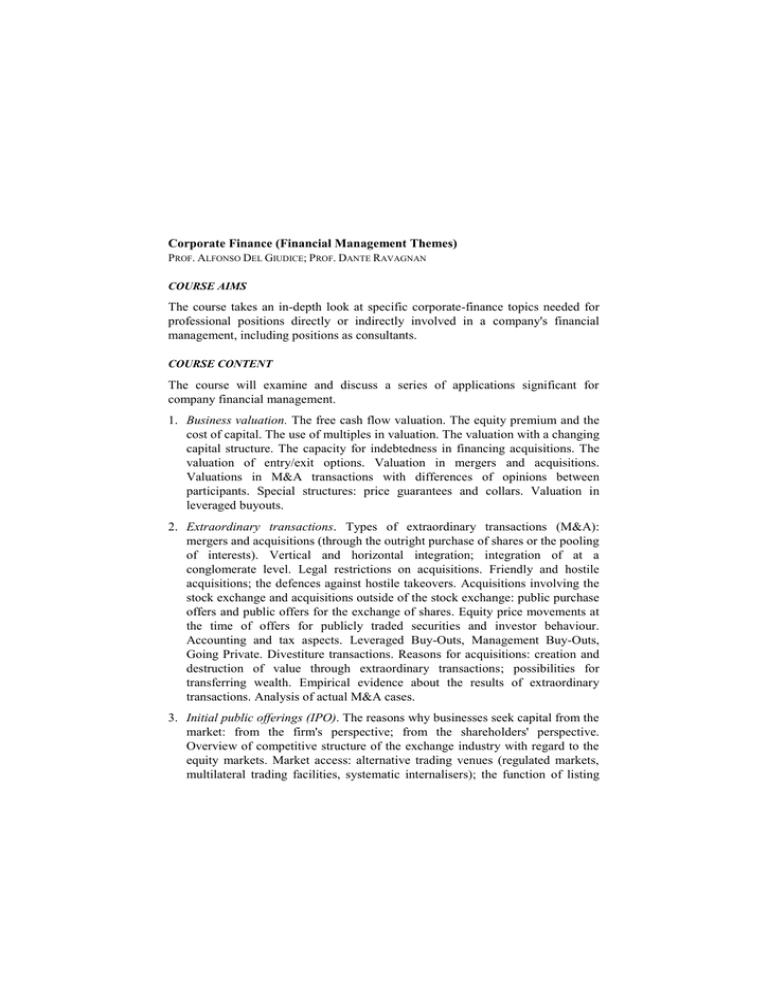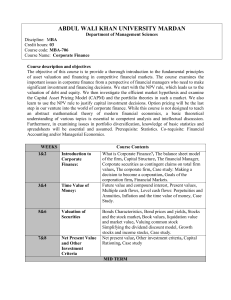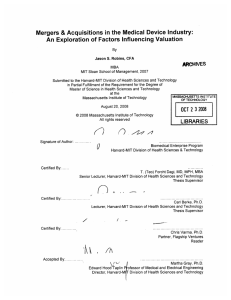Corporate Finance (Financial Management Themes)
advertisement

Corporate Finance (Financial Management Themes) PROF. ALFONSO DEL GIUDICE; PROF. DANTE RAVAGNAN COURSE AIMS The course takes an in-depth look at specific corporate-finance topics needed for professional positions directly or indirectly involved in a company's financial management, including positions as consultants. COURSE CONTENT The course will examine and discuss a series of applications significant for company financial management. 1. Business valuation. The free cash flow valuation. The equity premium and the cost of capital. The use of multiples in valuation. The valuation with a changing capital structure. The capacity for indebtedness in financing acquisitions. The valuation of entry/exit options. Valuation in mergers and acquisitions. Valuations in M&A transactions with differences of opinions between participants. Special structures: price guarantees and collars. Valuation in leveraged buyouts. 2. Extraordinary transactions. Types of extraordinary transactions (M&A): mergers and acquisitions (through the outright purchase of shares or the pooling of interests). Vertical and horizontal integration; integration of at a conglomerate level. Legal restrictions on acquisitions. Friendly and hostile acquisitions; the defences against hostile takeovers. Acquisitions involving the stock exchange and acquisitions outside of the stock exchange: public purchase offers and public offers for the exchange of shares. Equity price movements at the time of offers for publicly traded securities and investor behaviour. Accounting and tax aspects. Leveraged Buy-Outs, Management Buy-Outs, Going Private. Divestiture transactions. Reasons for acquisitions: creation and destruction of value through extraordinary transactions; possibilities for transferring wealth. Empirical evidence about the results of extraordinary transactions. Analysis of actual M&A cases. 3. Initial public offerings (IPO). The reasons why businesses seek capital from the market: from the firm's perspective; from the shareholders' perspective. Overview of competitive structure of the exchange industry with regard to the equity markets. Market access: alternative trading venues (regulated markets, multilateral trading facilities, systematic internalisers); the function of listing the securities exchanges; international perspective: the shopping of jurisdictions for incorporation and of markets for a listing; the segmentation of the Borsa Italiana and London Stock Exchange markets; Italian regulations on market access. Listing and corporate governance: the listing as a mechanism to separate ownership and control. Institutional investors and shareholder activism. Economics of the primary market: the system of incentives for intermediaries involved in placement and the phenomenon of underpricing; analysis of the economic reasons underlying offering techniques: fixed price versus open price; winner’s curse approach; bookbuilding versus auction; allotment; and greenshoe. The IPO process from the intermediary's point of view: pitch and mandate; pricing process; the definition of the structure of the offering (public sale offer versus public exchange offer); the offering memorandum; the creation of consortia; roadshows and offerings; the economics of the transaction (commissions). Financial analysts and IPOs: the activity of financial analysts; models used for valuation and sources of data; conflicts of interest in equity research activity; regulation. Analysis of an IPO case. READING LIST ARZAC, Valuation for mergers, buyouts, and restructuring, John Wiley & Sons, 2005 (Chapters and sections indicated in class). Lecture notes, reading references, and support materials will be indicated periodically in class. It should be noted that most of the reading material is in the English language. TEACHING METHOD The course will be taught through lectures. Considering the use of the textbook, and the fact that the lecture notes are closely related to other materials to be consulted, regular class attendance is highly recommended. ASSESSMENT METHOD Written test and eventual oral examination at the end of the course. NOTES The course deals with the application of concepts presented in Corporate Finance and Corporate Finance (Advanced Course); successful completion of both courses is a prerequisite for this course. In order to follow the lessons, students taking this course should have also successfully completed the course entitled Models for Financial Markets Derivatives Instruments; such course is an important requirement for those students earning a degree in Corporate Finance. Further information can be found on the lecturer's webpage at http://docenti.unicatt.it/web/searchByName.do?language=ENG, or on the Faculty notice board.









